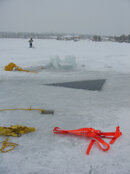gitterdun
Contributor
For what it's worth, I've had my inflator go on me, when I wasn't even using it, in 35 degree water. I was able to shut down my right post quickly, while dumping with my rear dump valve, which we have found is the easiest method for this failure. For water colder than 35/36, I will disconnect. I find it's one less thing I have to worry about. Orally inflating is not tough to do.








